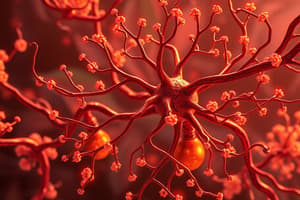Podcast
Questions and Answers
What is the function of the nicotinic receptor at the neuromuscular junction (NMJ)?
What is the function of the nicotinic receptor at the neuromuscular junction (NMJ)?
- Facilitation of ion transport
- Inhibition of muscle contraction
- Regulation of neurotransmitter release
- Activation of muscle contraction (correct)
Which type of receptors are expressed in skeletal muscles at the neuromuscular junction?
Which type of receptors are expressed in skeletal muscles at the neuromuscular junction?
- Dopaminergic receptors
- Adrenergic receptors
- Nicotinic receptors (correct)
- Muscarinic receptors
What are the possible targets for drugs acting at the neuromuscular junction?
What are the possible targets for drugs acting at the neuromuscular junction?
- Inhibition of ion channel function only
- Inhibition of neurotransmitter release only
- Enhancement of neurotransmitter release only
- Inhibition of both neurotransmitter release and ion channel function (correct)
Which process do cholinergic inhibitors primarily target at the skeletal neuromuscular junction?
Which process do cholinergic inhibitors primarily target at the skeletal neuromuscular junction?
What is the main therapeutic strategy for the treatment of myasthenia gravis?
What is the main therapeutic strategy for the treatment of myasthenia gravis?
What are the symptoms of anticholinesterase poisoning?
What are the symptoms of anticholinesterase poisoning?
What is the primary function of cholinesterase inhibitors?
What is the primary function of cholinesterase inhibitors?
What is the mechanism of action of Botulinum toxin?
What is the mechanism of action of Botulinum toxin?
What is the main therapeutic use of Botulinum toxin?
What is the main therapeutic use of Botulinum toxin?
Which type of NM blocker is succinylcholine?
Which type of NM blocker is succinylcholine?
What is the primary metabolic pathway for succinylcholine?
What is the primary metabolic pathway for succinylcholine?
Which drug is used for the reversal of non-depolarizing NM blockers like rocuronium?
Which drug is used for the reversal of non-depolarizing NM blockers like rocuronium?
What is the main therapeutic use of pralidoxime?
What is the main therapeutic use of pralidoxime?
What is the primary function of immunosuppressive treatment in myasthenia gravis?
What is the primary function of immunosuppressive treatment in myasthenia gravis?
Which symptoms are part of the mnemonic 'DUMBBELL' for acute intoxication with cholinesterase inhibitors?
Which symptoms are part of the mnemonic 'DUMBBELL' for acute intoxication with cholinesterase inhibitors?
Which nervous system response is associated with parasympathetic activation?
Which nervous system response is associated with parasympathetic activation?
Flashcards
Nicotinic Receptor at NMJ
Nicotinic Receptor at NMJ
A type of receptor found at the neuromuscular junction responsible for transmitting signals from nerves to skeletal muscles, enabling muscle contraction.
nAChR
nAChR
The specific type of nicotinic receptor present at the neuromuscular junction. It binds acetylcholine, triggering muscle contraction.
Drug Targets at NMJ
Drug Targets at NMJ
Drugs can act on the neuromuscular junction by targeting the nicotinic receptors, acetylcholine release, or cholinesterase.
Cholinergic Inhibitors
Cholinergic Inhibitors
Signup and view all the flashcards
Myasthenia Gravis Treatment
Myasthenia Gravis Treatment
Signup and view all the flashcards
Anticholinesterase Poisoning
Anticholinesterase Poisoning
Signup and view all the flashcards
Cholinesterase Inhibitors Function
Cholinesterase Inhibitors Function
Signup and view all the flashcards
Botulinum Toxin Mechanism
Botulinum Toxin Mechanism
Signup and view all the flashcards
Succinylcholine
Succinylcholine
Signup and view all the flashcards
Succinylcholine Metabolism
Succinylcholine Metabolism
Signup and view all the flashcards
Non-Depolarizing NM Blocker Reversal
Non-Depolarizing NM Blocker Reversal
Signup and view all the flashcards
Pralidoxime Therapeutic Use
Pralidoxime Therapeutic Use
Signup and view all the flashcards
Immunosuppressive Treatment in Myasthenia Gravis
Immunosuppressive Treatment in Myasthenia Gravis
Signup and view all the flashcards
Cholinesterase Inhibitor Intoxication Symptoms
Cholinesterase Inhibitor Intoxication Symptoms
Signup and view all the flashcards
Parasympathetic Nervous System
Parasympathetic Nervous System
Signup and view all the flashcards
Study Notes
Nicotinic Receptor at the Neuromuscular Junction (NMJ)
- The nicotinic receptor at the NMJ is responsible for transmitting neuronal signals to skeletal muscles.
Receptors in Skeletal Muscles at the NMJ
- Skeletal muscles at the NMJ express nicotinic receptors, specifically the nicotinic acetylcholine receptor (nAChR).
Targets for Drugs at the NMJ
- Possible targets for drugs acting at the NMJ include nicotinic receptors, acetylcholine release, and cholinesterase.
Cholinergic Inhibitors at the Skeletal NMJ
- Cholinergic inhibitors primarily target the breakdown of acetylcholine at the skeletal NMJ.
Treatment of Myasthenia Gravis
- The main therapeutic strategy for the treatment of myasthenia gravis is to increase the amount of acetylcholine available at the NMJ.
Symptoms of Anticholinesterase Poisoning
- Symptoms of anticholinesterase poisoning include muscarinic symptoms (salivation, lacrimation, urination, defecation), nicotinic symptoms (muscle weakness, paralysis), and central nervous system symptoms (confusion, agitation).
Cholinesterase Inhibitors
- The primary function of cholinesterase inhibitors is to increase the amount of acetylcholine available at the NMJ by inhibiting its breakdown.
Botulinum Toxin
- The mechanism of action of Botulinum toxin is to cleave the SNARE protein, preventing the release of acetylcholine from the neuron.
- The main therapeutic use of Botulinum toxin is for the treatment of muscle spasms and dystonias.
Succinylcholine
- Succinylcholine is a depolarizing NM blocker.
- The primary metabolic pathway for succinylcholine is through pseudocholinesterase.
Reversal of Non-Depolarizing NM Blockers
- Sugammadex is a drug used for the reversal of non-depolarizing NM blockers like rocuronium.
Pralidoxime
- The main therapeutic use of pralidoxime is to treat anticholinesterase poisoning.
Immunosuppressive Treatment in Myasthenia Gravis
- The primary function of immunosuppressive treatment in myasthenia gravis is to reduce the production of autoantibodies against the nicotinic receptor.
Symptoms of Acute Intoxication with Cholinesterase Inhibitors
- The mnemonic 'DUMBBELL' represents the symptoms of acute intoxication with cholinesterase inhibitors: D - diarrhea, U - urination, M - miosis, B - bradycardia, B - bronchospasm, E - emesis, L - lacrimation, L - loss of strength.
Nervous System Response
- Parasympathetic activation is associated with the release of acetylcholine and stimulation of the muscarinic and nicotinic receptors.
Studying That Suits You
Use AI to generate personalized quizzes and flashcards to suit your learning preferences.




